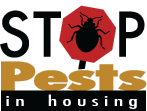- HOME
- » PEST SOLUTIONS
- » Lice
Lice
How to deal with lice
 |
|
Body louse. Photo by James L. Castner, UFL. |
 |
|
Head/body lice (left) and crab lice (right). UFL. |
See a doctor. Laundry, nit combs, and insecticidal shampoos should be used together to battle these bugs. Wash bedding, clothes, and hair accessories—the hotter the better. Combing should be done carefully—you should see the nits come off onto the comb. Insecticidal shampoos will be the crux of your solution, but read the label carefully. Follow the label—you're putting pesticides on your head. Since most products don't kill the nits, a repeat wash will need to be done in 10 days—after the eggs have hatched.
What they look like
The lice we're talking about here are ones that might be on you—head, body, or pubic lice. All are flat with feet made for gripping hair. Usually it's the eggs you spot. Look for tiny tan eggs—nits—glued to the base of hairs (head and pubic lice) or in fabric seams where they touch the skin (body lice).
Where they live
Unfortunately, on people. They don't live long without being able to suck blood. Although they can survive a few days away from their host—allowing for travel on hats, combs, or hair bands—they lay their eggs and prefer to hang out on us.
What they do
The main problem with lice is that they make us itch. Lice on people aren't the same as the lice on other animals, so no need to treat Lassie if you find them on yourself.
RESOURCES
See results from the Northeastern IPM Center's resources database.
